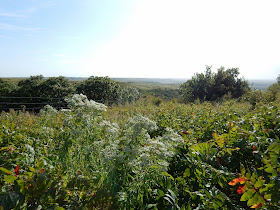Remember the story of Goldilocks and the Three Bears? Since Goldilocks was trespassing, I'm not sure she really should have been that picky. But I'm sure you remember the story: Papa Bear's porridge was too hot. Mama Bear's porridge was too cold. Baby Bear's porridge was just right. And so on and so forth.
Farmers like things "just right," too. For the first time in several years, conditions are right to apply anhydrous ammonia to the ground where we'll plant wheat in another 6 to 8 weeks or so.
We know we haven't put on anhydrous in the past five years, since I haven't ever written about it. (What? I thought I'd written about every detail of farm life at least one time!)
The ground might have been too hard. (Think 3-year-plus drought.)
The ground might have been too wet.
The ground may have had too much organic matter on top for the applicator to get through.
Time was ticking, and it didn't get done with everything else on the to-do list.
It's sounding a little like Goldilocks, right?
But this year, it's "just right."
NH3 - anhydrous ammonia - is less expensive than urea or liquid fertilizer. It is 82 percent nitrogen. Nitrogen is the most essential nutrient for crop development. Some nitrogen is formed by the breakdown of plant material in the soil. To achieve higher yields on most crops, additional nitrogen is needed.
We are applying about 60 pounds of actual nitrogen per acre as we put on anhydrous. We will probably add 10 pounds per acre as starter fertilizer when we plant wheat, along with some phosphorus.
Nitrogen is the most common element in the world. Air is mostly nitrogen but plants are unable to pull it out of the air.
Each tank holds about 2 tons of NH3. Each tank costs $1,120, or 38 cents per pound of actual nitrogen. Each tank covers a little more than 50 acres. We can run a tank out in about 2 hours. Cha-ching! Hopefully, it will pay off in better wheat yields next summer.
How many have we used? A lot. (I asked. That's the answer I got. I think my Farmer has lost track, but I'm sure the co-op has not. There's a reason we get our co-op bill in a manilla envelope.)
Jake has been running the tractor pulling the applicator and the anhydrous ammonia tank behind it. Randy has been the shuttle driver, pulling the tanks between the field and the co-op. He usually helps switch the tanks.
Natural gas is used in the manufacturing of anhydrous ammonia. It is a
more dangerous fertilizer to use in this form than urea or liquid
fertilizer. When it is exposed to air, it vaporizes. That's why we use
an applicator with knives that slice through the soil about 8 inches
deep, so when it vaporizes under the ground, it will attach to soil
particles that have moisture in them. Then, the plant can use the nutrient.
 |
| The NH3 comes out of the applicator here, when the applicator is in the soil. |
In the photo below, they are "bleeding" the tank before Randy unhooks it. (You can see the anhydrous ammonia vaporizing as it hits the air if you click on the photo and view it larger.) Randy stayed back during this process so that he didn't inhale any of the vapor.
He then removed the hose so that he could attach it to the next tank. Then he unhooked the tank from the applicator.
Jake then backed the tractor and applicator up so that Randy could hook up the new tank. Randy used those ubiquitous hand signals. While Randy hooked up the hoses to the applicator and the tank, Jake cleaned dirt out of the applicator "fingers."
Repeat as needed.
And hope we get it "just right."
Today, they'll continue the process. And my job will be supplying lunch and supper in the field. Hopefully, it will be "just right," too.
























































